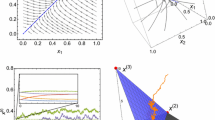Summary
We present the ideas, and their motivation, at the basis of a simple model of nucleic acid evolution: thestationary Markov process, or Markov clock. After a brief review of its relevant mathematical properties, the Markov clock is applied to nucleotide sequences from mitochondrial and nuclear genes of different species. Particular emphasis is given to the necessity of carrying out a correct statistical analysis, which allows us to check quantitatively the applicability of our model. We find evidence that the Markov clock ticks in many different processes, and that its limitations can be understood in terms of a simple idea that we call the “base-drift” hypothesis. This hypothesis correlates the deviations from the stationarity of the Markov process to the evolutionary distanced AB (P) of two species A and B, relative to the processP. We conclude by discussing the implications of our findings for future work.
Similar content being viewed by others
References
Attimonelli M, Lanave C, Sbisà E, Preparata G, Saccone C (1985) Multisequence comparisons in protein coding genes: search for functional constraints. Cell Biophys 7:239–250
Brown WM, Prager EM, Wang A, Wilson AC (1982) Mitochondrial DNA sequences of primates: tempo and mode of evolution. J Mol Evol 18:225–239
Farris JS (1981) Distance data in phylogenetic analysis. In: Funk VA, Brooks DR (eds) Advances in cladistics. New York Botanical Garden, New York, pp 3–29
Feller W (1966–1968) An introduction to probability theory and its applications. John Wiley & Sons, New York, vol I and II
Ferris SD, Wilson AC, Brown WM (1981) Evolutionary tree for apes and humans based on cleavage maps of mitochondrial DNA. Proc Natl Acad Sci USA 78:2432–2436
Gojobori T, Ishii K, Nei M (1982) Estimation of average number of nucleotide substitutions when the rate of substitution varies with nucleotide. J Mol Evol 18:414–423
Goodman M, Brounitzer G, Stangl A, Shrank B (1983) Evidence on human origins from haemoglobins of African apes. Nature 303:546–548
Gouy M, Gautier C, Attimonelli M, Lanave C, di Paola G (1985) ACNUC—a portable retrieval system for nucleic acid sequence databases: logical and physical designs and usage. CABIOS 1:167–172
Kimura M (1981) Estimation of evolutionary distances between homologous nucleotide sequences. Proc Natl Acad Sci USA 78:454–458
Kimura M (1983) The neutral theory of molecular evolution. Cambridge University Press, New York
Lanave C, Preparata G, Saccone C, Serio G (1984) A new method for calculating evolutionary substitution rates. J Mol Evol 20:86–93
Lanave C, Preparata G, Saccone C (1985) Mammalian genes as molecular clock? J Mol Evol 21:346–350
Lanave C, Tommasi S, Preparata G, Saccone C (1986) Transition and transversion rate in the evolution of animal mitochondrial DNA. BioSystems (in press)
Miyata T, Yasunaga T, Nishida T (1980) Nucleotide sequence divergence and functional constraint in mRNA evolution. Proc Natl Acad Sci USA 12:7328–7332
Saccone C, Preparata G, Lanave C, Tommasi S (1986) Building up molecular clocks from mitochondrial messenger RNA coding sequences. In: Pesce Delfino V (ed) Proceedings international meeting on biological evolution, Adriatica Ed Bari, Italy (in press)
Seuànez HN (1982) Chromosome banding and primate phylogeny. In: Chiarelli AB, Corruccini RS (eds) Advances views in primate biology. Springer-Verlag, Berlin, pp 224–235
Sibley C, Ahlquist JE (1984) The phylogeny of the hominoid primates, as indicated by DNA-DNA hybridization. J Mol Evol 20:2–15
Takahata N, Kimura M (1981) A model of evolutionary base substitutions and its applications with special reference to rapid change of pseudogenes. Genetics 98:641–657
Templeton AR (1983) Phylogenetic inference from restriction endonuclease site maps with particular reference to the evolution of humans and apes. Evolution 37:221–244
Wilson AC, Carlson SS, White TJ (1977) Biochemical evolution. Ann Rev Biochem 46:573–639
Yunis JJ, Prakash O (1982) The origin of man: a chromosomal pictorial legacy. Science 215:1525–1530
Zimmer EA, Martin SL, Beverley SM, Kan YW, Wilson AC (1980) Rapid duplication and loss of genes coding for the α chains of hemoglobin. Proc Natl Acad Sci USA 77:2158–2162
Zuckerkandl E, Pauling L (1962) Molecular disease, evolution and genetic heterogeneity. In: Kasha M, Pullman B (eds) Horizons in biochemistry. Academic Press, New York, pp 189–225
Author information
Authors and Affiliations
Rights and permissions
About this article
Cite this article
Preparata, G., Saccone, C. A simple quantitative model of the molecular clock. J Mol Evol 26, 7–15 (1987). https://doi.org/10.1007/BF02111277
Received:
Revised:
Issue Date:
DOI: https://doi.org/10.1007/BF02111277




